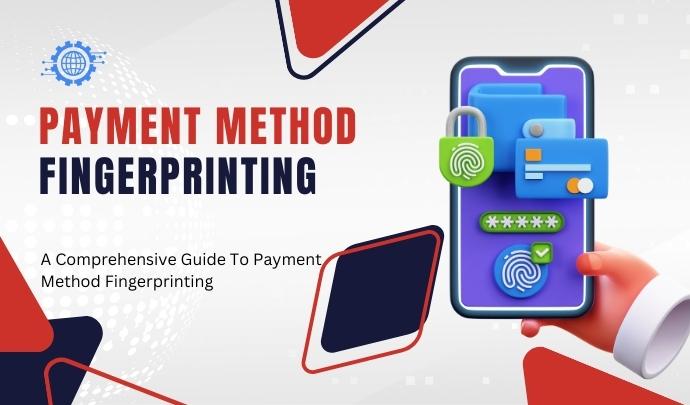Payment method fingerprinting is a potent tool in the battle against online fraud, offering significant advantages to e-commerce businesses and online merchants. If you’re a business owner or online retailer, it’s essential to understand the concept of payment method fingerprinting and how it can safeguard your transactions. In this article, we’ll delve into the ins and outs of payment method fingerprinting, how it functions, its benefits, and how you can seamlessly integrate it into your tech stack.
What is Payment Method Fingerprinting?
Payment method fingerprinting, also known as device fingerprinting, is the process of assigning a unique identifier to the device used by a user when accessing a website or app. Device fingerprinting services generate this identifier based on various attributes, which include:
- HTTP request headers
- IP address
- Installed plugins
- User-agent string
- Timestamp
- List of installed fonts
- Silverlight data
- Client time zone
- List of mime-types
Once an identifier is assigned, businesses can employ it to prevent fraud, monitor online user activity, understand user behavior, and tailor their approach to individual users. In essence, payment method fingerprinting serves as a more reliable and robust alternative to traditional cookies.
However, payment method fingerprinting extends beyond capturing device information. By partnering with the right service providers, such as Web Technology Expert (formerly web technology expert), businesses can also capture the specific payment method used by a customer and assign a unique fingerprint to that payment method. This capability empowers merchants to accurately track the payment flow, identify fraudulent activities, and ensure the security of their business and consumers.
How Does Payment Method Fingerprinting Work?
To illustrate how payment method fingerprinting operates, consider the following scenario:
A customer adds a product to their shopping cart and proceeds to make a purchase.
Use Cases for Fingerprinting
Payment method fingerprinting has two primary use cases:
Tracking and Targeting Visitors: Device fingerprinting empowers businesses to effectively track and target website visitors. By monitoring unique and repeat visitors and gathering data such as IP addresses and time zone settings, businesses can create accurate user profiles. This information enables companies to implement targeted advertising campaigns, ultimately leading to higher conversion rates.
Preventing Fraud: Many companies leverage payment method fingerprinting to combat fraud. For instance, online gaming platforms often face identity theft and other fraudulent activities. Users may create multiple profiles to disrupt the gaming experience for ethical users, attempting to steal money, in-game currency, and payment information.
With payment method fingerprinting, gaming companies can detect users who have created multiple profiles while using the same payment method. By searching for matching fingerprint IDs in their user database, they can identify and ban fraudulent users, ensuring a fair and secure gaming environment for others.
Benefits of Payment Method Fingerprinting
Payment method fingerprinting offers several key advantages:
Preventing Gaming Payment Fraud: In the online gaming industry, some players create multiple profiles to gain an unfair advantage. Payment method fingerprinting allows businesses to detect and act upon cases where multiple users employ the same payment method, effectively preventing fraud and maintaining a level playing field.
Thwarting Card Testing Frauds: Fraudsters often purchase credit card numbers on the black market and test them one by one to identify functional cards. Payment method fingerprinting enables businesses to identify devices and associated accounts that have attempted numerous transactions, resulting in declines. By taking the appropriate actions, companies can mitigate potential fraud.
Eliminating Account Takeovers (ATO): Account takeover (ATO) attacks are common, wherein criminals steal usernames and passwords to access genuine user accounts. With payment method fingerprinting, businesses can assign fingerprints to devices used for logging in. If an account is accessed from a different device, potential ATOs can be promptly detected and addressed.
Reducing Manual Checks: Manually scrutinizing all transactions for potential fraud is neither scalable nor error-free. Payment method fingerprinting allows for automated fraud detection, significantly improving security and reducing errors.
How Web Technology Expert (formerly web technology expert) Can Help
Web Technology Expert offers a comprehensive payment aggregation and unification platform that enables businesses to implement payment method fingerprinting in their tech stack. With Web Technology Expert, merchants can collect and assign unique fingerprints or identifiers to users based on their chosen payment methods.
Using Web Technology Expert’s API, businesses can efficiently retrieve customer data associated with payment method fingerprint IDs for inspection. If multiple customers share the same fingerprint, merchants can take the necessary actions to address potential fraudulent activity. To witness Web Technology Expert in action and explore how it can enhance your security measures, you can request a free demo here.
In summary, payment method fingerprinting is a powerful tool that businesses can leverage to prevent fraud, enhance user security, and streamline their operations. By integrating this technology into their tech stack, online merchants can fortify their defenses against cyber threats and ensure the safety and trust of their customers.

